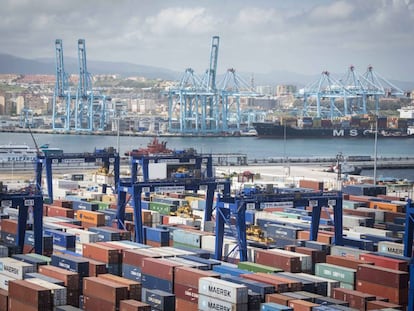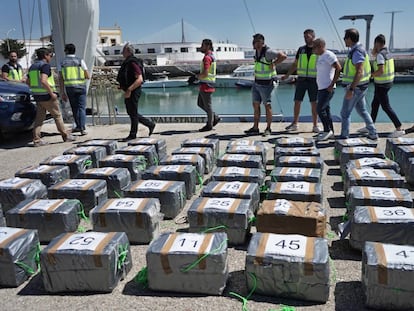The new cocaine lords of Galicia
After the excesses of the 1990s, the drug gangs from northwestern Spain have become adept at avoiding detection. But operating below the radar is a thriving transportation empire stretching all the way to Africa and the eastern Mediterranean
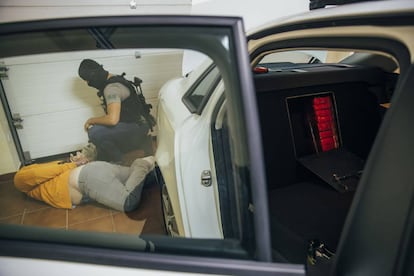
At 11am on November 15, 2018, the only people in the vicinity of a modern-looking house near the center of Pontevedra, in Spain’s northwestern Galicia region, were a man doing workouts, a couple out for a stroll, and a driver looking for parking space. A car and a van drew into the street. The gate to the house grounds rolled open and the vehicles disappeared inside.
This was the moment that Inspector Alfredo Díaz had been waiting for. Grabbing the heavy transmitter, he shouted into it: “Go!” Out of nowhere, two unmarked cars appeared suddenly and blocked the street at both ends. Four armed men wearing vests with POLICE on them got out and ran toward the house. So did the purported sportsman and the couple apparently out for a stroll.
On the other side of the gate, five people were stuffing packages into a secret compartment in the car. They could have been books and even had a cover depicting a horse’s head inside a horseshoe. The police burst in on them and shouted: “Get down!” The men did as they were told. Inspector Díaz took out his cellphone and made a call: “We’ve got the cocaine.”
O Salnés is also a place of international business that starts in the jungles of Colombia
It was the signal that his colleagues in Madrid and in Ribadumia (Pontevedra) had been waiting for: the green light to raid other houses. Altogether, Operation Poseidon – led by the Galicia Special Response Unit for Organized Crime (GRECO) – resulted in 15 arrests and the confiscation of 650 kilos of cocaine, with a street value of €39 million. It was not an unusual haul. As the chief of the Central Narcotics Brigade, Antonio Duarte, says: “Spain is still the second-biggest consumer of cocaine in Europe, lagging only behind the United Kingdom.”
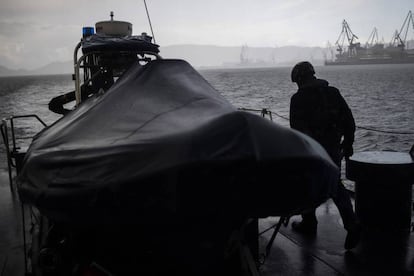
The scene
O Salnés is a region that lies between the Arousa and the Pontevedra estuaries. It is a summer paradise with sandy beaches, crystal-clear water and good food. But behind the picture-postcard image lies a different reality. O Salnés is also a place of international business that starts in the jungles of Colombia. Its players move €75 billion a year, a quarter of the Spanish budget, according to the UN Office On Drugs and Crime (UNODC). Travel agencies are aware of this, to the extent that the famous Repsol travel guide features a route from Noia to Cambados to see “the settings used by the Galician drug smugglers.”
O Salnés is the home turf of several of the 15 individuals arrested in Operation Poseidon, which was triggered by the activities in Colombia of a Galician man named Jorge Gómez Calviño, who once worked as a representative for the singer Manu Chao. The head of Greco Galicia, Emilio Rodríguez Ramos, knows the area like the back of his hand. “O Salnés is the epicenter of cocaine,” he says. “The people in this business find it easy to manage things from there. It’s their turf and their people. I walk into a bar there and I’m immediately being watched because of my slightly different accent.”
For those wishing to break into the business, role models in the drug trade abound in this part of the world. There is Sito Miñanco from Cambados, Laureano Oubiña, also from Cambados, and Manuel Charlín, from Vilanova de Arousa. The biggest narco mansions are here, though the extravagance has been toned down since the 1990s, when Porsches and Ferraris were a common sight on the streets.
“There is drug trafficking all over Spain,” says the mayor of Vilagarcía de Arousa, Alberto Varela of the Socialist Party (PSOE). “And sure, there are still drug traffickers here, but on a smaller scale. And they are also more discreet.”

According to Duarte, the drug smugglers now seek to stay below the radar. “Their biggest concern is being talked about, but in Galicia they are still the masterminds, the ones who have the links to the Colombians,” he says. “The Galicians are the only ones who the Colombians can give huge quantities of cocaine to in a boat. The Galicians organize everything. They take their cut at sea in the form of cocaine, and bring it to Galicia. The rest of the shipment is handed over to other buyers in Madrid, Barcelona and Rotterdam, to be distributed across Europe.”
The drug lords
According to the UNODC, more cocaine was produced in 2016 than ever before, with 1,410 tons coming out of the jungles of Colombia, Bolivia and Peru, 25% more than the previous year. Ever since the Colombian government and the FARC revolutionary forces signed a peace deal in September 2016, many of the former guerrillas have gone into cocaine production, according to the US Drug Enforcement Administration. “Right now, the Colombians need to get rid of their excess,” says the report.
This explains why Daniel “El Loco” Barrera, who succeeded Joaquín “El Chapo” Guzmán – a Mexican drug lord now languishing in jail in the US – has given the order to “flood” the Galician estuaries with drugs. Dairo Antonio Úsuga, aka “Otoniel,” the head of the Gulf cartel, also has an interest in Galicia: it is where he sends his envoys, according to investigative journalist Víctor Méndez Sanguos, whose essay Narcogallegos (or, Galician Narcos) has become something of a bible for the narcotics squads.
Meanwhile, the drug lords of O Salnés have the one essential thing it takes to operate efficiently. “Direct contact with the Colombian suppliers. Direct,” underscores Duarte. “They go to Colombia; they might even spend a few months out of the year there. That makes the drugs cheaper for them and allows them to reduce the risks.”
For those wishing to break into the business, role models in the drug trade abound in this part of the world
The police have almost 100 people under surveillance in Galicia suspected of links to the drug trade. The list is secret, but several names repeatedly crop up in the local media: Óscar Manuel Rial Iglesias, aka “El Pastelero,” or “The Baker;” José Constante Piñeiro Búa, aka “Costiñas,” and Juan Manuel Vidal Padín, otherwise known as “El Burro,” or “The Donkey.”
There is only one photo of The Baker’s face on the internet. It was taken in 2013 during the trial of the San Miguel, a fishing vessel caught in 2008 in the middle of the Atlantic Ocean by the Customs Surveillance Unit as it was offloading 3,400 kilos of cocaine onto several speedboats. The Baker is seen seated in the second row of defendants inside Spain’s High Court, the Audiencia Nacional, right behind Costiñas. Approximately 40 years old, dark and strongly built, he was charged with directing the operation along with Costiñas. But the charge rested on the testimony of a seaman who had been in their employ. The police had been protecting him for a number of years but, gangster-style, he disappeared on the eve of the trial. Before he vanished, however, he left a notarized letter in which he asked The Baker for forgiveness, assuring that everything he had told the authorities up to that point had been a lie.
It was the second time that The Baker had gotten off scot-free from a drug-smuggling charge. In 2006, he had been secretly recorded by police, again with Costiñas, during a meeting with various Colombian and Galician drug lords held, of all places, inside the 12 de Octubre hospital in Madrid. It took five more years for the police to identify the voices. When they were brought before a judge, he took the controversial decision to order their release.
Curiously, The Baker was finally caught in 2014 for tax fraud – not drug trafficking. He paid a €700,000 fine to the Tax Agency and posted bail of €200,000 without batting an eye. Since then, he has kept a low profile, like his friends Costiñas and The Donkey. The only thing known about The Donkey is that he runs several businesses in O Salnés and lives in Colombia for most of the year.
Víctor Méndez, the author of Galician Narcos, talks about the trio’s obsession with avoiding detection and reveals the following anecdote: “One of them took a trip by motorbike with his gang from the Arousa River to Santiago de Compostela. Before leaving, he told his companions not to lift the visors on their helmets because the police could be watching them. At the Santiago tollbooth, 10 kilometers from the city, one of them lifted his visor to pay. Nothing was said at the time, but when they reached the city, he was taught a lesson.”
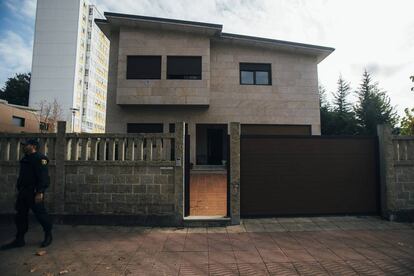
The police have to tread carefully when dealing with the drug lords, as their lawyers include some of the highest-paid legal brains in the country, including Gonzalo Boye, the attorney for the drug lord Sito Miñanco and also for Carles Puigdemont and other Catalan separatist politicians on the run. Judge José Antonio Vázquez Taín remarks that at the end of the day, it is the lawyers who have the most to gain from the whole sordid business.
The export agents
Sito Miñanco was still Number One when he was arrested at his home in Algeciras last year. Found inside his home was the script of the TV show Fariña (available on Netflix), which focuses on the time this drug lord moved into the cocaine business after trawling up and down the Arousa River in speedboats filled with tobacco. Charged and jailed for being the main player in a distribution chain that took in Spain, the Netherlands, Italy and Albania, his exit from the scene marked the end of an era. He was the last of the old-timers who could buy the drug in South America and bring it to Europe. This task is now carried out by others. Most of those featured in the Fariña series are now working on commission.
The drug lords of O Salnés have the one essential thing it takes to operate efficiently. “Direct contact with the Colombian suppliers”
O Salnés has plenty of these second-tier characters. Duarte says that most have got their Colombian contacts from jail. “In prison, they say, ‘I have speedboats, I have boats, I have people to smuggle the drugs, I have cars with secret compartments, satellites, radios… I have everything.’ So when they come out, contact is made: ‘Hey, there’s an operation. Have you got a boat?’ And they say: ‘Of course! But you have to give me €150,000’.” Prison is known as “the university.”
When they are arrested, many of those working on commission plead ignorance. “I’ve never seen a package of drugs in my life!” they say, according to Duarte. “They think they have nothing to worry about, but they can get up to 10 years for their involvement.”
One step down from those working on commission are the owners of the speedboats and those who store the goods. But the men who unload the drugs at the foot of the cliffs and the drivers of the vans that take them to storage run a huge risk for the sake of a few thousand euros. They can be jailed for as long as 10 years while someone set to gain as much as €500 million will get 12 to 14 years. Two years ago, the Supreme Court sent 15 members of two major drug rings to prison. The police seized €5 billion in properties, but 99.9% of them belonged to just three members of the ring. The others owned next to nothing. “I believe there was one guy who got 10 years who had been receiving help from the charity Cáritas in Vilanova de Arousa to feed his wife and children,” says chief inspector Rodríguez Ramos.
The business
Cocaine is big business, depending on where you are in the chain. A kilo of cocaine is worth €2,200 in the Colombian jungle, but that becomes €29,000 on Galicia’s beaches and €60,000 on the streets of Madrid, Barcelona and Seville. The problem is getting it from A to C, but the Galicians have a reputation for being the best in Europe.
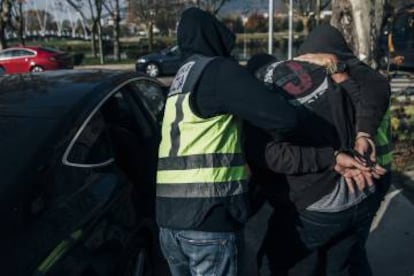
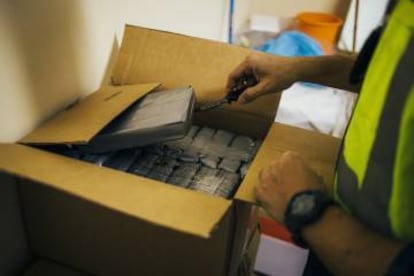
“There are two main groups that have the financial means to organize operations,” says Ramos. These two groups not only bring the drugs into Galicia, they can also arrange for their entry into ports in Algeciras, Valencia and Rotterdam. Their main strength, as Sito Miñanco pointed out, is that they are natural-born seamen.
“In Galicia there is a great shipbuilding tradition,” says Galicia’s head of customs, Jaime Gayá. “Many of the drug boats that have been picked up in the Strait of Gibraltar were built in Galicia.”
According to Ambrosio Fontes, head of the Galician Foundation against Drug Trafficking and a member of the Customs Surveillance Unit, the new boats are 20 meters long and have seven 300-horsepower motors that can take them all the way to Cape Verde, off the west coast of Africa.
When he designed the operation that landed him in jail a year ago, Miñanco used three means of transportation: a merchant ship bound for the Netherlands, a fishing boat as cover, and powerful speedboats to pick up the cocaine as it traveled along the coast of Galicia. The Colombian drug lords don’t pay the Galicians in money, but in drugs. “That way they make sure they are not only a means of transportation but also the owners of at least some of the smuggled goods,” explains Pablo Varela, a prosecutor in Pontevedra. “If the Colombians lose, so do the Galicians. Their interests are mutual.”
The commission ranges from 20% to 25% of the cargo and usually the “payment” takes place about 85 nautical miles off the coast. Often it is picked up by speedboats, but sometimes a fishing vessel will go to collect the cargo and bring it into the designated port. In either case, there are a lot of people involved in the operation – those getting the commission, the seamen, the speedboat drivers, those who pick up the shipment and those who store the drugs, who will often be expected to hang on to them if the price is down due to excess supply. These fluctuations in price do not, however, affect the street value, which is kept at between €50 and €60 a gram.
The emigrants
The Galician drug lords keep a watchful eye on police activity from their mansions in O Salnés. The pressure is rising. The biggest cocaine hauls in Europe are taking place in Spain. In 2017, 49.9 tons were seized by the police – about half of the total.
In their bid to sidestep the police, the drug lords are using locations further afield to store their cargo. Last November the police arrested José Carlos Pombar, 64, in Panama. Pombar is a Galician who specializes in picking up cocaine at sea and taking it for storage to countries such as Mauritania, Guinea and Nigeria. As in Europe, when the ship gets close to the coast of these African countries, a crew is sent out to pick up the goods in the fishing waters. When the drugs are finally sold, they are brought to Europe among cargoes of fish.
Like Pombar, many Galicians living in Africa are on the run from the law in Spain. Among them is the former police officer Miguel Ángel Devesa, who was arrested in 2011 in a warehouse in Mali. When the local police asked him why there was blood on the floor, he told them that he and his friends had just killed a lamb for Ramadan. When the police subsequently found the body of a Colombian in pieces in the freezer, Devesa tried to bribe them with €20,000. The police turned down the money and arrested him. Days later, the authorities concluded that Devesa had been involved in the case of the Boeing 727 that had landed two years before in the Mali desert with five to 10 tons of cocaine on board. He went to jail for just two years and police are convinced he is now back in action.
Drug lords are also looking to expand into Turkey, and scouts have already been sent to investigate the possibility of hiring boats there.

Society
The offices of the Galician Foundation against Drug Trafficking occupy one of the main squares of Vilagarcía de Arousa. Duarte states that if it weren’t for this organization, Galicia would have gone to the dogs.
The manager of the foundation, Fernando Alonso, believes that society is strongly against the trafficking of drugs, but not so much against it when it comes to the money it generates. “In certain circles, crime persists as a lifestyle,” he says. “It has been passed down from fathers to sons to grandsons and it means that the origins of certain companies are swept under the carpet. A man who opens a bar and sells coffees for 50 cents, or another one who sells running shoes at half price... those are not businesses, they are money-laundering outfits.”
Meanwhile, the politicians tend to play down the problem. The mayor of Vilagarcía says that the public image of Arousa estuary is “totally distorted” and he quotes statistics to back this up. “The crime rate here is 22% while the Spanish average is 44%,” he says. “It’s a very peaceful area with significant marine-research centers for Europe, and sailing centers that produce Olympic medalists.”
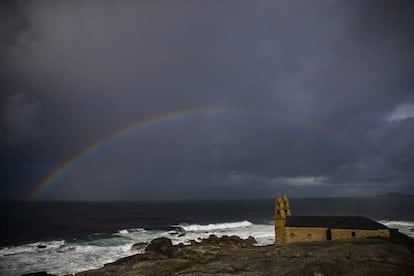
Félix Porto, the mayor of Muxía, capital of the Costa da Morte area, refuses to accept there is a problem. “There are a lot of attractive things about Muxía, and [drugs] is not one of them. My job is to promote the positive things about the city,” he says.
According to the journalist Víctor Méndez, there is a tendency in Galicia to respond to the situation by looking the other way. “Plenty of people know what their neighbor is up to, but they don’t report them,” he says. “They are like, ‘As long as it doesn’t affect me, he can do whatever he likes’.”
Consequently, there appears to be no trouble, which is just the way the drug traffickers like it. The police are aware of the problem. They have a webpage where people can report suspicious behavior but Duarte says that people are scared. “There are some reports, but very few. Really very few,” he says.
Meanwhile, the drug traffickers keep at it. “If we aren’t careful,” says Duarte, “they’ll eat us alive.”
English version by Heather Galloway.
More information
